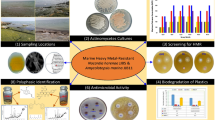Abstract
Hypersaline Phormidium strains were grown in media amended with naphthalene and anthracene. Phormidium tenue was identified as tolerating and effectively degrading polycyclic aromatic hydrocarbons that may be toxic in the environment. GC/MS analysis explained the degradation of these compounds by P. tenue. A dioxygenase enzyme system was evident by the formation of anthracene dione as the first degradation compound. This strain could be used for bioremediation of polycyclic aromatic hydorcarbon pollution on seashores.


Similar content being viewed by others
References
Al-Hasan RH, Al-Bader DA, Sorkhoh NA, Radwan SS (1998) Evidence for n-alkane consumption and oxidation by filamentous cyanobacteria from oil contaminated coasts of the Arabian Gulf. Mar Biol 130:521–527
Budzinski H, Raymond N, Nadalig T, Gilewicz M, Garrigues P, Bertrand JC, Caumette P (1998) Aerobic biodegradation of alkylated aromatic hydrocarbons by a bacterial community. Org Geochem 28:337–348
Cerniglia CE, Gibson DT (1979) Algal oxidation of aromatic hydrocarbons: formation of 1-naphthol from naphthalene by Agmenellum quadruplicatum, strain PR-6. Biochem Biophy Res Commun 88:50–58
Cerniglia CE, Gibson DT, Van Baalen C (1980a) Oxidation of naphthalene by cyanobacteria and microalgae. J Gen Microbiol 116:495–500
Cerniglia CE, Van Baalen C, Gibson DT (1980b) Metabolism of naphthalene by cyanobacteria Osillatoria sp., strain JCM. J Gen Microbiol 116:485–494
Davis JI, Evans WC (1964) Oxidative metabolism of napthalene by soil Pseudomonds. The ring-fission mechanism. Biochem J 91:251–261
Fernley HN, Evans WC (1958) Oxidative metabolism of polycyclic hydrocarbons by soil Pseudomonads. Nature 182:373–375
Mackinney J (1941) Absorption of light by chlorophyll solutions. J Biol Chem 140:315–322
Mahajan MC, Phale PS, Valdyanathan CS (1994) Evidence for the involvement of multiple pathways in the biodegradation of 1- and 2- methylnaphthalene by Pseudomonas putida CSV86. Arch Microbiol 161:425–433
Malins DC, Krahn MM, Brown DW, Rhodes LD, Myers MS, McCain AB, Chan S (1985) Toxic chemicals in marine sediment and biota from Mukilteo, Washington: relationship with hepatic neoplasm and other hepatic lesions in English sole (Parophrys vetulus). J Natl Cancer Inst 74:487–494
Mansy AE, El-Bestway E (2002) Toxicity and biodegradation of fluometuron by selected cyanobacterial species. World J Microbiol Biotechnol 18:125–131
Menzie CA, Potocki BB, Santodonato J (1992) Exposure to carsinogenic PAHs in the environment. Environ Sci Technol 26:1278–1284
Narro ML, Cerniglia CE, Van Baleen C, Gibson DT (1992) Metabolism of phenanthrene by marine cyanobacterium Agmenellum quadruplicatum PR6. Appl Environ Microbiol 58:1351–1359
Prince RC (1998) Crude oil biodegradation. In: Meyers RA (ed) Encyclopedia of environmental analysis and remediation. Wiley, New York, pp 1327–1343
Radwan SS, Al-Hasan (2000) Oil pollution and cyanobacteria. In: Whitton BA, Potts M (eds) The ecology of cyanobacteria. Kluwer, The Netherlands, pp 307–319
Raghukumar C, Vipparty V, David JJ, Chandramohan D (2001) Degradation of crude oil by marine cyanobacteria. App Micobiol Biotechnol 57:433–436
Rippka R, Deruelles J, Waterbury JB, Herdmann M, Stanier RY (1979) Generic assignments, strain histories and properties of pure cultures of cyanobacteria. J Gen Microbiol 111:1–61
Tian L, Ma P, Zhong JJ (2002) Kinetics and key enzyme activities of phenanthrene degradation by Pseudomonas mendocina. Process Biochem 37:1431–1437
Yan GA, Jiang JW, Wu G, Yan X (1998) Disappearance of linear alkylbenzene sulfonate from different cultures with Anabaena sp. HB 1017. Bull Environ Contam Toxicol 60:329–334
Acknowledgements
The authors are grateful to the Ministry of Earth Sciences (MoES), and University Grants Commission (UGC), Government of India, for the financial support. The first author acknowledges the Rajiv Gandhi National Fellowship (RGNF) Scheme for the fellowship.
Author information
Authors and Affiliations
Corresponding author
Rights and permissions
About this article
Cite this article
Kumar, M.S., Muralitharan, G. & Thajuddin, N. Screening of a hypersaline cyanobacterium, Phormidium tenue, for the degradation of aromatic hydrocarbons: naphthalene and anthracene. Biotechnol Lett 31, 1863–1866 (2009). https://doi.org/10.1007/s10529-009-0085-3
Received:
Revised:
Accepted:
Published:
Issue Date:
DOI: https://doi.org/10.1007/s10529-009-0085-3




